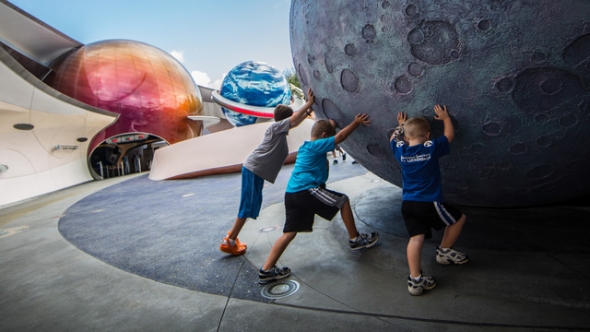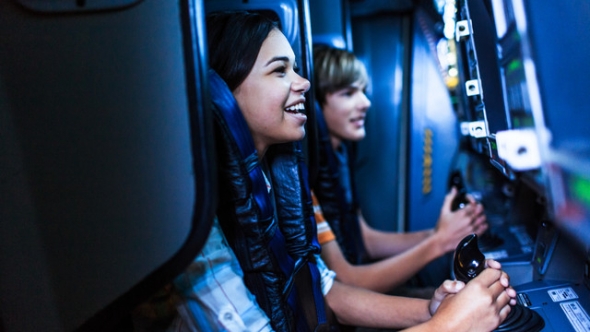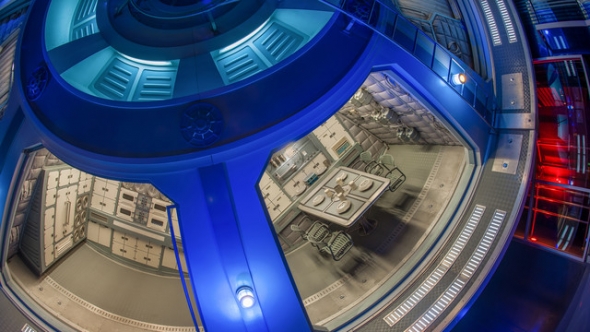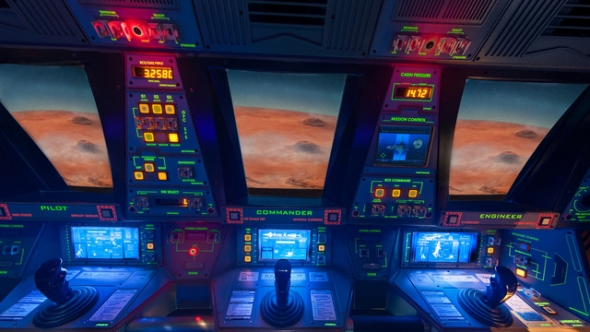Does this ride make me look fat?
Image: Disney
The construction of Mission: Space was costly, to be sure. Disney invested $100 million in the tear-down and rebuild of the former Horizons building. It’s far from the most expensive attraction at Epcot, but it’s also a bit pricier than, say, Journey into Imagination with Figment. And from the beginning, Imagineers and NASA experts alike understood that what they were planning would push the limits of theme park tourism, albeit with a remarkably straightforward ride structure.
Anyone who speaks of amusement park attractions occasionally tosses out the term g-force, as if they could teach a physics class on the subject. That’s because the underlying premise is simple. When you experience a G of force, your body feels as if it’s twice its normal weight. As someone who weighs about 215 pounds, that means a single G turns me into a sumo wrestler. Two Gs means I feel like Ahab the determined sailor is my mortal enemy.
We’re all the same in this regard. No feeling is as strange to humans as the sensation of g-force, which is why there are all those funny videos demonstrating what it does to a human face. Space travel demands a lot of facial combat with dramatic g-force. In order to simulate this sensation, NASA developed something their trainees do not affectionately describe when they call it the Vomit Comet. It’s a stress test for the human body, revealing which potential candidates can hold up to the extreme challenges of g-forces and zero-gravity environments.
Centrifugal Me
Image: Disney
As a reminder, NASA does this to test the best and the brightest among their ranks. Disney Imagineers consulted with NASA, eventually settling on the construction of a ride that basically does the same thing. It was a bold gambit as well as a questionable decision that many Disney fans debate to this day. Suffice to say that there’s a difference between someone competing to earn a trip to the International Space Station and a theme park visitor sneaking in a four-minute ride before their dinner reservation triggers at the World Showcase.
Disney believed that they could pull off the feat. They designed a structure similar to classic amusement park rides of old. It’s a series of rides connected to spokes. A large apparatus is the wheel that tethers each piece together. If you struggle to visualize this description, here’s a terrific explanation from someone who used CAD to create a mock-up. The trick is that classic amusement cart rides spin people from the bottom up. Mission: Space inverts the structure. The spokes point down instead of up. Otherwise, the premise is generally the same.
Image: Disney
The catch is that Disney wasn’t satisfied repurposing a classic amusement park staple. Instead, they wanted to add their own twist, the zero-gravity element that creates the sensation of space travel. The attraction is a trip to Mars, after all.
The first phase of the journey is lift-off from planet Earth. That requires a great deal of friction in the form of 2.5 Gs, which means that if you weigh 200 pounds, you’ll feel as if you’re 500 pounds during the start of Mission: Space. It’s in this phase where the centrifuge comes into play. The structure whips you around at an alarming rate.
Once you reach orbit, the sensation changes. You are now in a zero-gravity environment. Nothing holds you in place. You’ll feel as if you’re floating weightlessly. Mission: Space thrusts you into a confusing combination of experiences that transpire in a single minute of real-time. First, you weigh too much and then you weigh nothing at all.
If that doesn’t make you dizzy, well, Disney has you covered. The final part of the ride is a controlled crash landing on the surface of Mars. Mission: Space is functionally a stress test of the entire human body. To wit, it’s neither the fastest nor most thrilling ride at Walt Disney World. Despite this, it IS the only attraction that includes a motion sickness bag.
Early warning signals
Image: Disney
NASA engineers alerted Disney to the potential downsides of their joint venture. When Mission: Space debuted in August of 2003, many of the opening day comments focused on the comical number of warning signs in the line queue. The company understood the dangers. It’s hard not to laugh about them when listed together.
Due to the isolation of the ride cart, which is functionally a tiny closet enclosure, it’s terrible for sufferers of claustrophobia. Because of the twirling and dramatic weight changes in a short period, Mission: Space isn’t for pregnant women or guests with heart conditions. Yes, a lot of rides state those terms. The difference is that this attraction has tragically proven its dangers.
What’s important right now is that Disney was so well aware of the potential nausea issues for their ride that they built a rest area just outside the ride. When Cast Members recognize that a guest is suffering from the lingering effects of Mission: Space, they take the person to this room, which has various bathroom cabinet types of medical options and a sink. Most guests simply sit still until they can catch their breath and feel the room stop spinning. Stating the obvious, interplanetary space travel isn’t for everyone.
In addition to having onsite caregiving just outside the ride, Disney added warnings as a key part of the Cast Member dialogue. They wanted all the potential riders to understand the challenge they were embracing. Alas, sometimes a batch of warning signs and ride restrictions simply adds to the intrigue. Epcot never had the reputation as a thrill ride park. The introduction of a 2.5-G attraction that also simulates zero-gravity conditions wasn’t something that guests would ignore.





Comments
I rode Mission Space years ago, and was nauseated for three hours afterwards. Now being older I have been experiencing claustrophobia, so I will not ride Mission Space ever again. Sad.
Fascinating--I hung on every word. But I still don't know exactly where I stand on Mission:Space. I rode the intense side first, didn't effect me too much, but on each time after that, I rode the green side. I think the warning signs need to be in more languages--Could that German woman read of the dangers the ride presented?
Germany is a bilingual country for the most part, with most people speaking English in addition to German.